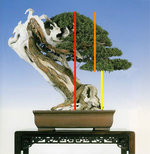It would be helpful if you told us more about the process...what did you measure and change to make image 1 conform more closely to the golden mean?
I think the whole spiral thing has people confused. The golden ratio or golden mean is simply when you divide a line so that the ratio of the longer segment to the total is the same as the shorter segment to the longer segment. It is an irrational number that is infinite and non-repeating, similar to pi. But rather than get into a confusing discussion about math, think about it as dividing anything into two pieces of approx 62% length and 38% length. If you want to continue the sequence, you would go to the longer piece and divide it again, by 62% and 38%, and so on.
But I don't want to confuse the discussion by talking about infinite series - like branches moving up a trunk, development of ramification, etc. I tried to create the most simple example I could - that of an informal upright bonsai with a descending branch. The descending branch is the focus of the design, and the height of the bonsai foliage is the total design height. Therefore, according to the Golden Mean, the design will be "in balance" if the descending branch descends to 38% of the height to the total tree.

In this case the ratio of orange line to red line is exactly equal to ratio of yellow line to orange line.
It is a design guideline to help you decide "how far should I let that branch descend?" And people are absolutely correct - some people will be able to eyeball it or just "feel" it. They might start with design 3 and say "way too long" and go to design 1 and say "too boring" and go to design 2 and say "just right".
Again this is an "exploration" of this design principle. It is not to say it is an absolute law to be followed.
It is really hard to create these examples, because as people have pointed out, if you DID decide to go with design 1, you probably would do something different with the foliage while maintaining the same general ratios and outline.
By the way - to point out other aspects of this design. Notice how the apex is exactly centered over the nebari, and the line of the deadwood trunk is exactly parallel to the outline of the foliage.


